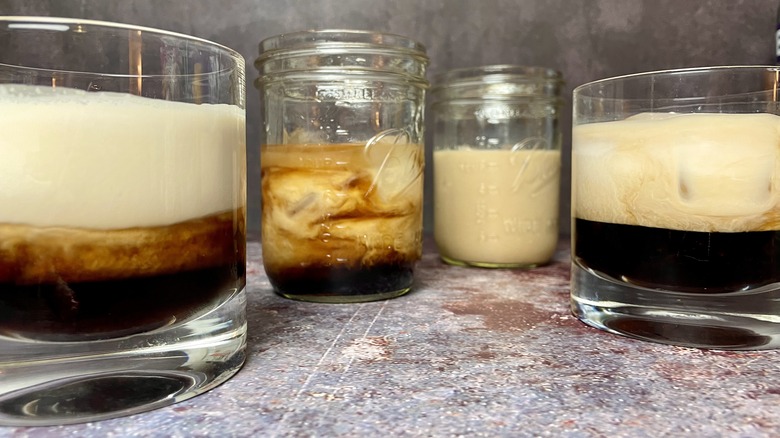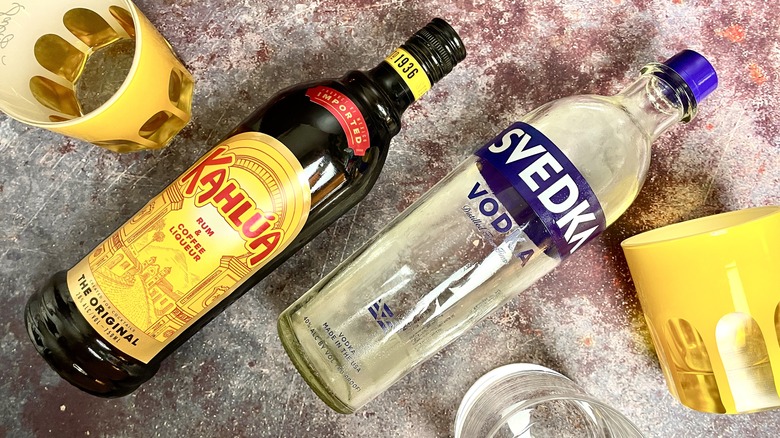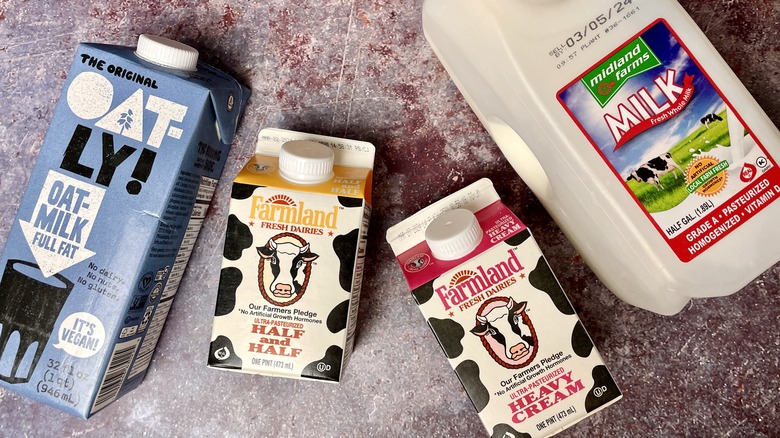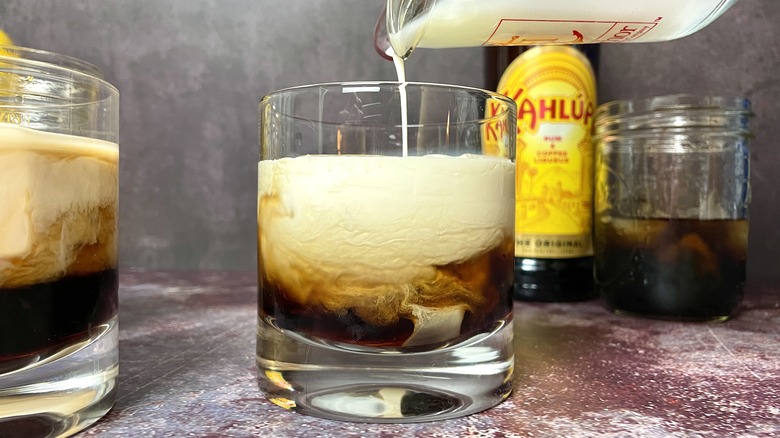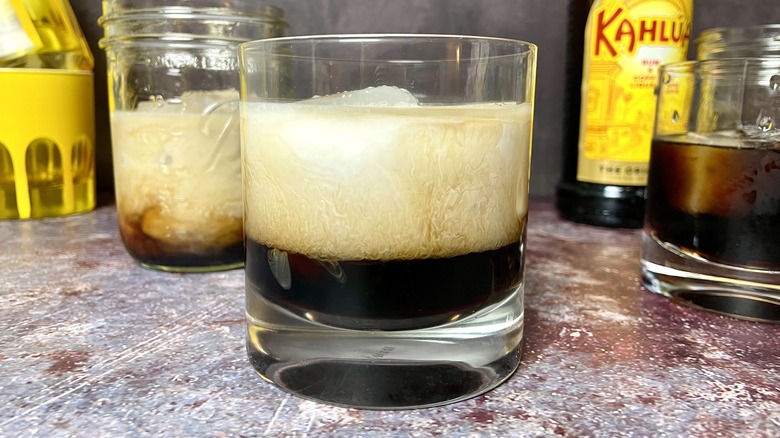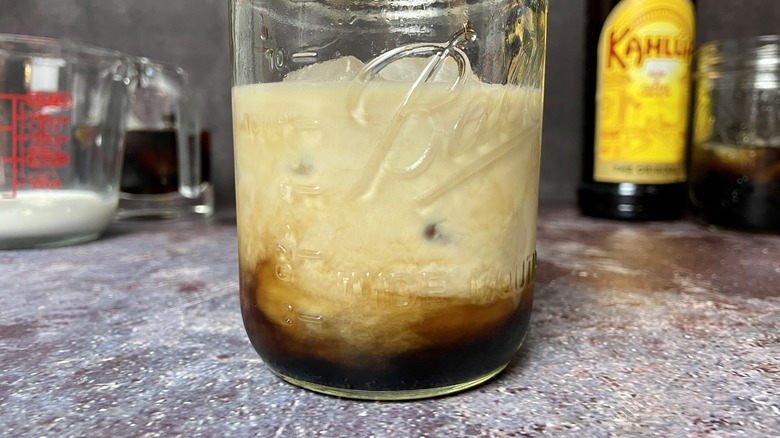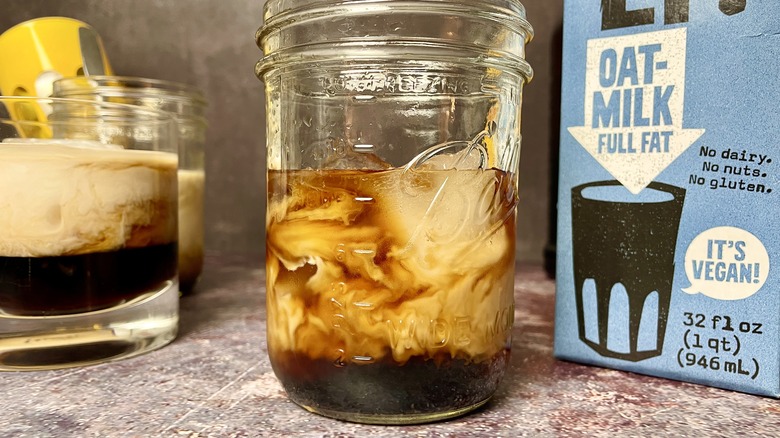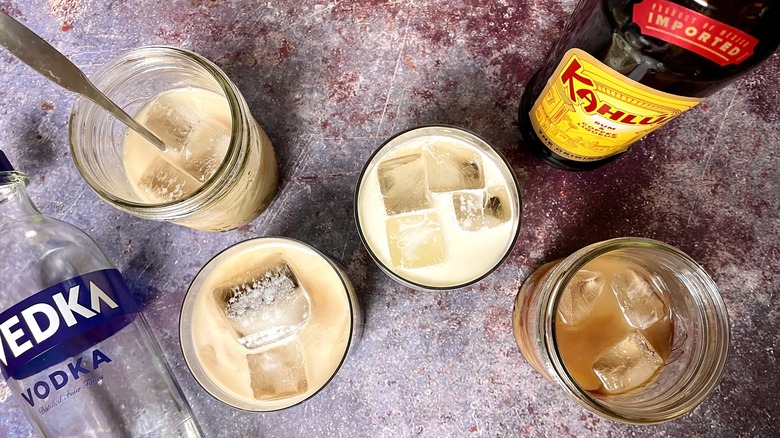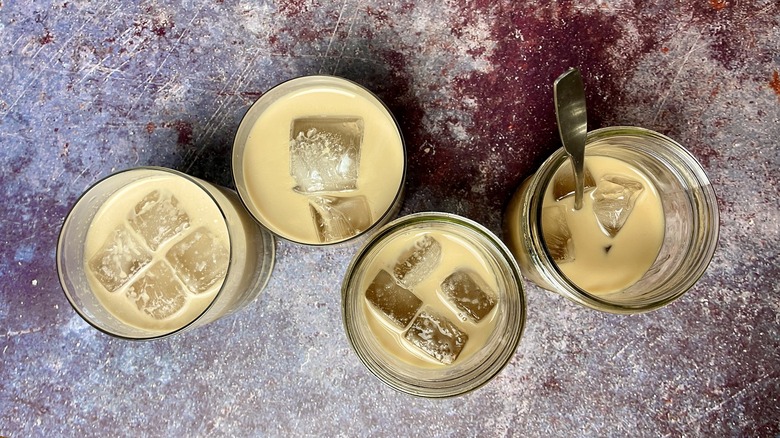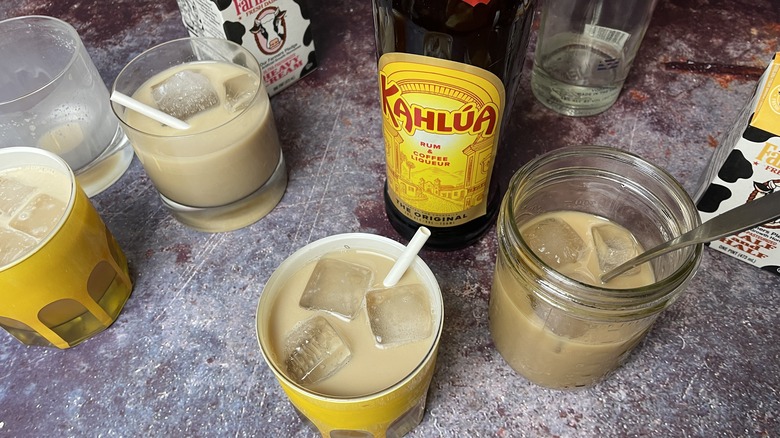We Tried 4 Kinds Of Dairy To Find Which Makes The Perfect White Russian Cocktail
Stirring up a cocktail at home can be such a satisfying way to kick off a relaxing evening. Drinks made with ingredients of equal proportions can make the process less intimidating and much easier to perfect. You'll recognize several popular and classic cocktails in the equal-parts cocktails category, including the 50/50 martini, the Negroni (and its many iterations), and of course, the White Russian.
Despite its name, there's very little Russian influence behind the White Russian. Instead, the "Russian" portion of the name simply refers to the inclusion of vodka. According to some accounts, the predecessor to the drink — the Black Russian — was created by a Belgian bartender around 1949 in a Brussels hotel. It's assumed that the cream component was added to the drink sometime in the 1950s, establishing the White Russian as the boozy adult version of a milkshake.
Classically, White Russians are made with equal parts vodka, coffee liqueur, and cream. Some purists argue that cream is the only dairy to use when making the drink, though if you have to, you can substitute half-and-half for the cream. Others are just fine with using milk to lighten the drink up, or even a non-dairy creamer as an alternative. So, to find the most pleasing dairy option, I refilled all of my ice cube trays, picked up several dairy options and a fresh bottle of Kahlúa, and mixed up enough White Russians in a single afternoon to make even The Dude tipsy. Here's what I found out.
Choosing a vodka and coffee liqueur
While the vodka in this cocktail is what makes it "Russian," your options for vodka are nearly endless these days. In fact, at the end of 2023, the top five countries exporting vodka were Sweden, France, Poland, the U.S., and the Netherlands, making for a dizzying array. Ultimately, you should just reach for the vodka you like the best. To make a classic White Russian, you should stick with an unflavored vodka until you're comfortable mixing the drink and know what kind of direction you'd like to take the flavor in. From there, you can easily play with syrups to add additional flavor or seek out a flavored vodka to accent your drink.
When it comes to coffee liqueurs, few brands have the same kind of name recognition that Kahlúa does, but it's hardly the only option on the market. Borghetti liqueur is known for its stronger espresso punch and less sweet finish. Mr. Black is a relative newcomer to the coffee liqueur world and has made a strong name for itself during the espresso martini renaissance of the last few years. Even lower-priced liqueurs, like Tia Maria, can offer well-rounded and bold flavors to balance your cocktail.
Ultimately, I chose to go with Kahlúa since it's widely recognizable, and something I'd gladly mix into other cocktails (or even sip on its own). For vodka, I picked up a bottle of Svedka vodka because it was available at a reasonable price.
Differences in the dairy options
When testing the different dairy options for the White Russian, I mixed cocktails with heavy cream, half-and-half, whole milk, and XXX non-dairy cream. Perhaps, most obviously, the biggest difference between the dairy options is their fat content, which in turn affects the thickness and mouthfeel of each drink. Cream is typically available in "heavy" and "light whipping" options, with heavy cream having a minimum of 36% milk fat. Light whipping cream is just a touch lighter, with anywhere from 30 to 35% milk fat. The heavy cream I used clocked in at 50 calories per tablespoon, with 5 grams of fat, 20 mg of cholesterol, 5 mg of sodium, and 0 grams of carbohydrates.
Half-and-half is fundamentally half milk and half cream and typically has a milk fat percentage of 10 to 18%. The brand I used has 20 calories per tablespoon, 1.75 grams of fat, 5 mg of cholesterol, 15 mg of sodium, and less than 1 gram of carbohydrates. Whole milk alone contributes a little more than 9 calories per tablespoon, half a gram of fat, 2 mg of cholesterol, 8 mg of sodium, and less than one gram of carbohydrates. The nutritional value of non-dairy milk and creams varies greatly, but the Oatly full-fat oat milk I chose has about 10 calories per tablespoon, half a gram of fat, no cholesterol, just over 6 grams of sodium, and less than 1 gram of carbohydrates.
Heavy cream test
First, I measured out four glasses of vodka and Kahlúa with one ounce of each liquor by volume, then added ice cubes to each glass. Each glass then got a one-ounce pour of one of the dairy options. The very first thing I noticed when pouring in the heavy cream was how the higher-fat cream was much whiter and essentially floated on the liquor in the glass, remaining separated until I stirred them together. The heavy cream version of the cocktail is noticeably creamy and thick, but the flavor of the coffee liqueur and potent vodka tingle still manage to shine through.
Even though the heavy cream has a higher fat content than the other dairy options by double or more, there might be a hidden benefit to this option for some people. Those who are lactose intolerant could have fewer issues consuming heavy cream since it typically has about 0.43 grams of lactose per tablespoon. The threshold for tolerating lactose is different for everyone but generally averages about 12 grams of lactose before any side effects are triggered. There are about two tablespoons per ounce, but even if someone was enjoying a double White Russian with four tablespoons, the drink would still contain less than two grams of lactose, which could make the entire experience more enjoyable in more ways than one.
Half-and-half test
If you were to put the heavy cream version of the White Russian in front of me next to the half-and-half version in a blind tasting, it would probably take me two or three sips to be able to tell them apart. But if I had to choose which drink was which based on looks alone, it would be immediately clear which was which. That's because the White Russian that was made with heavy cream is noticeably lighter in color than the half-and-half version.
However, the higher fat content of the half-and-half makes for a drink that has a thicker and creamier mouthfeel, while also clearing a little more room on the palate for the bite of the liquor to shine through. It's not quite as luxurious as the heavy cream version of the drink, but it's not watered-down or lackluster either.
When pouring the drink, the dairy still floats on top of the liquor and requires a little stirring to emulsify. This option can also pull double duty if you already have half-and-half on hand for your morning coffee. What's more, it also has a relatively lower lactose content for those looking for a lactose-intolerant-friendly option, though those who are especially sensitive may still want to steer clear.
Whole milk test
There's just enough fat in whole milk to impart a little bit of smoothness to the White Russian. However, if you are sticking to the equal parts ratio, the milk only serves to tie the vodka and coffee liqueur together a little more, taste-wise, by buffering some of the sharper notes from each of the alcohols. In other words, there's no way you can confuse this version of the drink with the classic heavy cream version, but it's still better than going without any milk at all.
If the milk-based version of the White Russian was served warm, it's not hard to see how you could enjoy it in much the same way as you might an Irish coffee (albeit without the whiskey). It's clear that there's dairy in the drink, but it's not the main ingredient by a long shot, at least when it comes to flavor. As for texture, the mouthfeel is a lot more subtle than the higher-fat dairy options and is almost replaced by the stronger burn from the vodka and coffee liqueurs.
Full fat oat milk test
Much like it would take me a few sips to tell the difference between the cream and half-and-half-based White Russians in a blind tasting, it would also probably take a few sips for me to notice the difference between a milk-based cocktail and an oat milk version. That's largely because the oat flavor of this plant-based milk is almost completely overshadowed by the bite of the vodka and coffee liqueur in this version of the White Russian. The oat milk also doesn't change the body and texture of the drink in any substantial way. This is absolutely a scenario where I'd be tempted to add more oat milk to the White Russian to help balance the drink a little more.
When it comes to non-dairy alternatives, there are more plant-based milk options than I could possibly tackle here. But generally speaking, I would take care to choose an alternative milk or creamer with as much fat in it as possible and without any additional flavoring. Vanilla or sweetened varieties will easily blend into the cocktail if that's all you can lay your hands on, or if you want a little extra flavor to mask the taste of the non-dairy creamer you've chosen.
Adjusting the cocktail ratio
While the 1:1:1 ratio of the White Russian makes it easy to remember and measure, no rule says you have to stick to that religiously. While I'd say that it's a reasonable ratio when mixing the drink with cream, I'd absolutely suggest altering it a bit if using another kind of dairy — or even just to suit your tastes.
If you prefer the taste of coffee liqueur to the taste of vodka, consider adjusting the proportions to make the coffee liqueur more apparent. Instead of an ounce of each, try .75 ounces of vodka and 1.25 ounces of coffee liquor, and continue to adjust the ratio until it reaches your ideal balance — up to one part vodka and two parts coffee liqueur.
Adjusting the dairy will likely affect the potency of your drink, but what ultimately matters is that it's enjoyable. One part cream to two parts liquor works well if using heavy cream, but the drop in milk fat content when using half-and-half, milk, or a non-dairy milk alternative makes for a noticeable difference in both flavor and texture. If using half-and-half, consider upping the amount to 1.5 parts dairy to one part vodka and one part coffee liqueur. If using milk or a non-dairy alternative, I'd even consider mixing a drink with equal parts dairy to the entire liquor volume (for example: one ounce of vodka and one ounce of coffee liqueur to two ounces of milk).
Final verdict: The thicker the better
Heading into this tasting, I assumed that I would prefer the lighter versions of the White Russian — that is, those that were made with half-and-half or whole milk. But after the very first sip of the White Russian I mixed with heavy cream, there was no going back. The cream-based White Russian, served ice cold, is just what I had in mind when imagining a boozy milkshake-style cocktail. It's rich, for sure, and I'm not sure I could down more than two of them in one sitting, given how heavy they are, but it's by far the most indulgent and yet balanced version of the drink.
That said, I don't always keep heavy cream in the fridge. I'd be happy to make a White Russian with whatever dairy I have on hand, so long as I was adjusting the ratios to balance the liquor and milk. For someone who already enjoys a Black Russian cocktail — or sweet black coffee, for that matter — the addition of milk or half-and-half might be the ideal move. The lower fat content in the dairy lets the liquor shine through, which isn't especially appealing to me, but it might be for others. Essentially, a milky White Russian is what I'd serve to someone I was trying to wean off of espresso martinis, or what I'd make if I only had vodka and Kahlúa but didn't have access to an espresso machine and a shaker.
Methodology
I take my coffee with a short teaspoon of sugar and a generous pour of whole milk. On occasion, I'll use half-and-half, but I don't typically keep it in the fridge. I think heavy cream is generally a touch too rich for my (admittedly weak) cup of morning joe. But a stronger drink, such as a White Russian, seems more fitting for a bolder dairy, especially if it even remotely resembles a milkshake. I can't say no to full-fat coffee ice cream in just about any form it comes in, and I would gladly take it spiked or floating in a boozy affogato any day.
While testing, I started with the heavy cream version of the White Russian for two reasons. First, because it's considered the original preparation and so was the standard that I wanted to base my opinion on moving forward. I also went this route because I wanted the drinks to get progressively lighter as I made my way through the tastings, a decision that I made entirely for digestive purposes.
To cleanse my palate between each cocktail — and stave off a hangover before making it to the end of the tasting — I kept a glass of lemon water handy to help cut through any residual fat build-up on the tongue. I narrowed the options down to my favorite two and remade the cocktails with those two dairy options the next day to confirm my choice with a clearer head and fresh palate.
